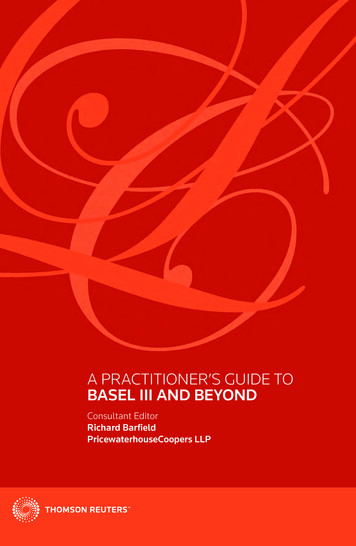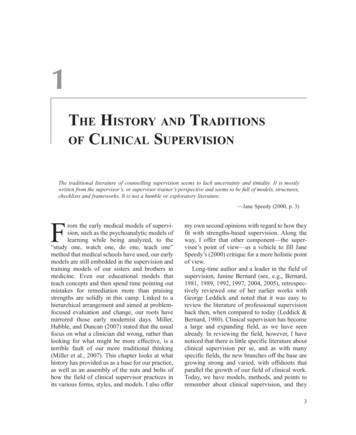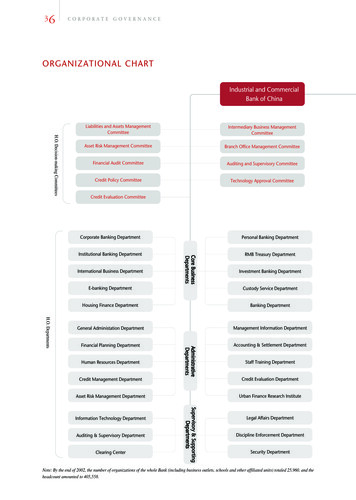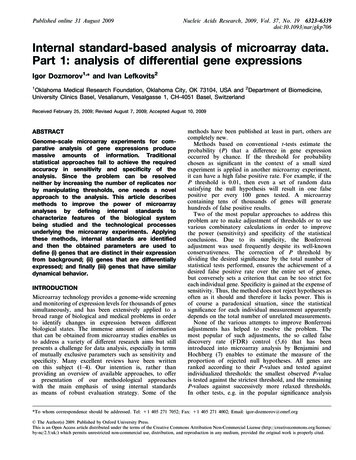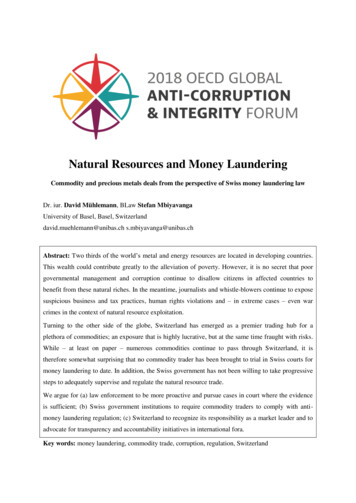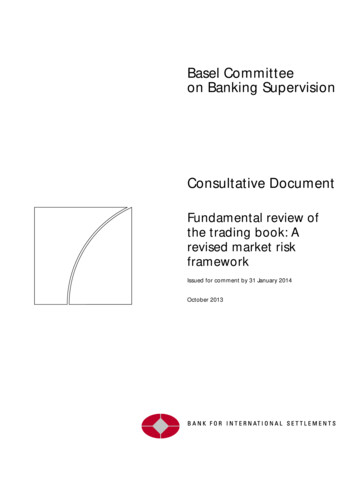
Transcription
Basel Committeeon Banking SupervisionConsultative DocumentFundamental review ofthe trading book: Arevised market riskframeworkIssued for comment by 31 January 2014October 2013
This publication is available on the BIS website (www.bis.org). Bank for International Settlements 2013. All rights reserved. Brief excerpts may be reproduced ortranslated provided the source is stated.ISBN 92-9131-971-6 (print)ISBN 92-9197-971-6 (online)
ContentsExecutive summary . 1Section 1: Overall revisions to the market risk framework . 71.1The trading book/banking book boundary . 71.2Treatment of credit . 101.3Factoring in market liquidity . 131.4Choice of market risk metric and calibration to stress conditions . 181.5Treatment of hedging and diversification. 191.6Relationship between the standardised and internal model-based approaches. 21Section 2: Revised models-based approach. 232.1The overall approach to internal models-based measurement . 232.2The identification of eligible trading desks . 25Section 3: Revised standardised approach . 313.1Objectives and rationale for a revised standardised approach . 313.2General features of the revised standardised approach . 323.3Calibration of the revised standardised approach. 343.4Proposed treatments by asset class . 35Section 4: Disclosure requirements . 44Section 5: Impact assessment. 45Annex 1: Revised market risk framework . 46Annex 2: Actions to reduce variation in risk-weighted assets for market risk . 116Glossary .121Fundamental review of the trading book: A revised market risk frameworkiii
Fundamental review of the trading book: A revised market riskframeworkExecutive summary1This is the Basel Committee’s (“the Committee”) second consultative paper on the fundamental review2of trading book capital requirements. The revisions to the capital framework set out in this paper aim tocontribute to a more resilient banking sector by strengthening capital standards for market risks. Theyform part of the Committee’s broader agenda to reform regulatory standards for banks in response tothe financial crisis. The revisions in this paper also reflect the Committee’s increased focus on achieving aregulatory framework that can be implemented consistently by supervisors across jurisdictions. As such,they incorporate the lessons learned from the Committee’s recent investigations into the variability of3market risk-weighted assets.BackgroundThe financial crisis exposed material weaknesses in the overall design of the framework for capitalisingtrading activities. The level of capital required against trading book exposures proved insufficient toabsorb losses. As an important response to the crisis, the Committee introduced a set of revisions to themarket risk framework in July 2009 (part of the “Basel 2.5” package of reforms). At the time, theCommittee recognised that the Basel 2.5 revisions did not fully address the shortcomings of theframework. In response, the Committee initiated a fundamental review of the trading book regime,beginning with an assessment of “what went wrong”. The Committee published the first consultativepaper in May 2012. Having reflected on comments received, this paper sets out more detailed proposalsfor reforming the trading book regime, including draft text for the Basel Accord.Key areas of Committee focusThe Committee has focused on the following key areas as part of its review:1The Basel Committee on Banking Supervision provides a forum for regular cooperation on banking supervisory matters. Itseeks to promote and to strengthen supervisory and risk management practices globally. The Committee comprisesrepresentatives from Argentina, Australia, Belgium, Brazil, Canada, China, France, Germany, Hong Kong SAR, India, Indonesia,Italy, Japan, Korea, Luxembourg, Mexico, the Netherlands, Russia, Saudi Arabia, Singapore, South Africa, Spain, Sweden,Switzerland, Turkey, the United Kingdom and the United States. Observers on the Basel Committee are: the EuropeanBanking Authority, the European Central Bank, the European Commission, the Financial Stability Institute and theInternational Monetary Fund.2To view the first consultative paper, see Basel Committee on Banking Supervision, Fundamental review of the trading book,May 2012 (www.bis.org/publ/bcbs219.pdf). It is intended that this second consultative paper can be read as a standalonedocument, without the need for cross reference with the first consultative paper.3See Basel Committee on Banking Supervision, Regulatory consistency assessment programme (RCAP) – Analysis of riskweighted assets for market risk, January 2013 (revised February 2013), www.bis.org/publ/bcbs240.pdf.Fundamental review of the trading book: A revised market risk framework1
The trading book/banking book boundaryThe Committee believes that the definition of the regulatory boundary between the trading book andbanking book has been a source of weakness in the design of the current regime. A key determinant ofthe boundary has been banks’ self-determined intent to trade. Trading intent has proven to be aninherently subjective criterion that is difficult to police and insufficiently restrictive from a prudentialperspective in some jurisdictions. Coupled with large differences in capital requirements against similartypes of risk on either side of the boundary, the overall capital framework proved susceptible toarbitrage before and during the crisis.In May 2012, the Committee put forward for consideration two alternative definitions for theboundary: a trading evidence-based approach and a valuation-based approach. Having reflected onfeedback from the first consultative paper, the Committee has developed a revised boundary that retainsthe link between the regulatory trading book and the set of instruments that banks deem to hold fortrading purposes, but seeks to address weaknesses in the boundary by reducing the possibility ofarbitrage and by providing more supervisory tools. As such, this boundary is more likely to be alignedwith banks’ own risk management practices relative to the valuation-based approach.The Committee is seeking to deliver more consistent implementation of the boundary acrossbanks. Based on the new definition, the Committee provides example instruments which have to beassigned either to the banking book or to the trading book. For certain instrument types, there will be apresumption that they are included in the trading book. This will facilitate the development of acommon understanding among supervisors regarding the types of instrument that would typically beincluded in the different books. The Committee has also agreed on a range of documentation that bankswould need to make available to supervisors, as part of new valuation and evidence-based reportingrequirements for all trading book positions. This will facilitate a better understanding of the types ofactivity that are within the scope of trading book capital requirements, and increase the supervisability ofthe boundary.The Committee remains concerned about the risk of arbitrage. To reduce the incentives forarbitrage, the Committee is seeking a less permeable boundary with stricter limits on switching betweenbooks and measures to prevent “capital benefit” in instances where switching is permitted. TheCommittee is also aiming to reduce the materiality of differences in capital requirements against similartypes of risk on either side of the boundary. For example, the Committee has decided that the calibrationof capital charges against default risk in the trading book will be closely aligned to the banking booktreatment, especially for securitisations. The Committee is also investigating the development of Pillar 1charges for interest rate and credit spread risk in the banking book.Reflecting the revised boundary’s focus on contributing to reducing arbitrage rather than onquantitative evidence as a condition for inclusion in the trading book, the Committee is referring to thenew boundary simply as “the revised boundary” (rather than “the evidence-based boundary”). Section 1sets out the main changes to the boundary, and provides a proposed “presumptive list” of instrumentspresumed to be included in the trading book as well as a list of instruments that does not meet therevised definition of the trading book.Treatment of creditCredit-related products were a key source of losses during the crisis and the treatment of these positionsproved particularly flawed. In responding to the lessons from the crisis, the Committee has agreed, as ageneral principle, to bring trading book requirements closer to those of the banking book. Morespecifically, the Committee has agreed a differential approach to securitisation and non-securitisationexposures:2Fundamental review of the trading book: A revised market risk framework
Securitisation exposures: The Committee remains sceptical that existing internal models-basedrisk measurement methodologies used by banks can adequately capture the risks associatedwith securitised products. As a result, capital charges for securitisation positions in the tradingbook – including correlation trading activities – will be based on the revised standardisedapproach. This also simplifies the framework by obviating the need for a specific “correlationtrading portfolio” (CTP). Non-securitisation exposures: Internal modelling will continue to be allowed for nonsecuritisation positions. But the Committee has decided that joint modelling of the discrete(default risk) and continuous (spread risk) components of credit risk is likely to involve particularpractical challenges. It could also make a more consistent capital treatment of credit risk acrossthe balance sheet more difficult to achieve. As a result, the Committee has agreed that nonsecuritisation credit positions in the trading book will be subject to a separate IncrementalDefault Risk (IDR) charge. Credit Valuation Adjustments (CVA) charges: Basel III introduced a new set of capital charges tocapture the risk of changes to CVA, collectively known as the CVA risk capital charge. The firstconsultative document discussed whether CVA should be captured in an integrated fashionwith other forms of market risk within the market risk framework or continue to be calculated asa standalone capital charge. For the time being, the Committee has decided that it is notappropriate for CVA to be fully integrated into the market risk framework. The Committeebelieves that CVA must be treated separately given the complexity and model risk in anintegrated model and that allowing full integration may lead to significant variation in results. Alimited number of changes to the CVA calculation are being introduced to maintain consistencywith the revised market risk requirements set out in this paper.Approach to risk measurementIn considering the overall approach to risk measurement for minimum capital requirements, theCommittee has confirmed its intention to pursue two key reforms outlined in the first consultative paper: Stressed calibration: The Committee recognises the importance of ensuring that regulatorycapital will be sufficient in periods of significant market stress. As the crisis showed, it isprecisely during stress periods that capital is most critical to absorb losses. Furthermore, areduction in the cyclicality of market risk capital charges remains a key objective of theCommittee. Consistent with the direction taken in Basel 2.5, the Committee will address bothissues by moving to a capital framework that is calibrated to a period of significant financialmarket stress in both the internal models-based and standardised approaches. The Committeeis aware that similar care is needed in selecting appropriate periods of stress, recognising thatin general not all asset classes or exposures are subject to market stress at the same time. Move from Value-at-Risk (VaR) to Expected Shortfall (ES): A number of weaknesses have beenidentified with using VaR for determining regulatory capital requirements, including its inabilityto capture “tail risk”. For this reason, the Committee proposed in May 2012 to replace VaR withES. ES measures the riskiness of a position by considering both the size and the likelihood oflosses above a certain confidence level. The Committee has agreed to use a 97.5% ES for theinternal models-based approach and has also used that approach to calibrate capitalrequirements under the revised market risk standardised approach.Overall, the Committee believes these changes represent a rationalisation of the frameworkwith the internal models-based approach moving to a single, stressed metric.Fundamental review of the trading book: A revised market risk framework3
A comprehensive incorporation of the risk of market illiquidityIn the 2012 consultative paper, the Committee recognised the importance of incorporating the conceptof relative liquidity and the risk of market illiquidity in banks’ regulatory capital requirements for tradingportfolios. Before the introduction of the Basel 2.5 changes, the market risk framework was based on anassumption that trading book risk positions were all liquid, ie that banks could exit or hedge thesepositions over a 10-day horizon. The recent crisis proved this assumption to be false. As liquidityconditions deteriorated during the crisis, banks were forced to hold risk positions for much longer thanexpected and incurred large losses from changes in values due to fluctuations in liquidity premia.The Committee’s approach to address the risks posed by varying market liquidity consists of twoelements: First, incorporating “liquidity horizons” in the market risk metric. This is broadly in line with thedirection taken under Basel 2.5, which introduced varying liquidity horizons as part of theIncremental Risk Charge (IRC) and the Comprehensive Risk Measure (CRM). A liquidity horizonis defined as “the time required to execute transactions that extinguish an exposure to a riskfactor, without moving the price of the hedging instruments, in stressed market conditions”.Banks’ risk factors will be assigned five liquidity horizon categories, ranging from 10 days to oneyear. To ensure consistency in capital outcomes, and in balancing the trade-off betweensimplicity and risk sensitivity, the Committee has agreed to assign liquidity horizons at the levelof broad categories of risk factors. This regulatory assessment of liquidity has also beenincorporated in the calibration of the standardised approach. Second, in May 2012, the Committee had proposed introducing capital add-ons against the riskof jumps in liquidity premia. The objective was to identify instruments where historical pricedata used in the regulatory market risk metric would not sufficiently reflect this risk, as was thecase with some structured credit products in the run-up to the crisis. Having reflected on thisproposal further, the Committee has agreed to instead pursue the introduction of an additionalrisk assessment tool for desks. This will not depend on internal models, reflecting theCommittee’s broader concerns around excessive reliance on market risk models that usehistorical price volatility to deliver capital charges. The assessment will seek to identify desksthat trade particularly illiquid, complex products and to form part of the requirements forallowing model permission for these desks.Treatment of hedging and diversificationHedging and diversification are intrinsic to the active management of trading portfolios. Hedging, whilegenerally risk-reducing, also gives rise to basis risk (and creates counterparty risk). And portfoliodiversification benefits can disappear in times of stress. Currently, banks using the internal models-basedapproach are allowed generous recognition on the risk-reducing benefits of hedging and diversification,while recognition of such benefits is strictly limited under the standardised approach. The Committee isproposing to more closely align the recognition of hedging and diversification between the twoapproaches. For the internal models-based approach, this will be achieved by imposing some constraintson recognising diversification benefits. For the revised standardised approach, the recognition ofhedging and diversification will be significantly increased relative to the current approach.Relationship between internal models-based and standardised approachesAs set out in May 2012, the Committee considers the current regulatory capital framework for thetrading book to have become too reliant on banks’ internal models that reflect a private view of risk. Inaddition, the potential for very large differences between standardised and internal models-based4Fundamental review of the trading book: A revised market risk framework
capital requirements for a given portfolio can leave supervisors without a credible option of removingmodel permission when model performance is poor.The Committee is taking a number of steps to strengthen the relationship between modelsbased and standardised approaches. First, it is establishing a closer link between capital chargesresulting from the two approaches. Second, it will require mandatory calculation of the standardisedapproach by all banks. Third, it will require mandatory public disclosure of standardised capital chargesby all banks on a desk-by-desk basis. Finally, the Committee is also considering the merits of introducingthe standardised approach as a floor or surcharge to the models-based approach.Revised models-based approachAs stated in the first consultative paper, the Committee has identified a number of weaknesses with riskmeasurement under the models-based approach under the 1996 market risk amendment. Specifically,the 10-day VaR calculation did not adequately capture credit risk or market liquidity risks; incentivisedbanks to take on tail risk; inadequately captured basis risk and proved procyclical due to its reliance onrelatively recent historical data. In seeking to address these problems, the Committee proposed to: (i)strengthen requirements for defining the scope of portfolios that will be eligible for internal modelstreatment; and (ii) strengthen internal model standards to ensure that the output of such models reflectsmore fully the relevant trading book risks from a regulatory perspective.To strengthen – and make more objective – the criteria for allowing banks to calculate capitalrequirements using internal models, the Committee has agreed to break the model approval processinto smaller, more discrete steps, including at the trading desk level. The Committee has also agreed ona set of quantitative tools to measure the performance of models. First, a P&L attribution process thatprovides an assessment of how well a desk’s risk management model captures risk factors that drive itsP&L. Second, an enhanced daily backtesting framework for reconciling forecasted losses with actuallosses. Where a trading desk fails these tests, the bank would be required to calculate capitalrequirements for that desk using the standardised approach. Finally, as mentioned above, theCommittee will also pursue the introduction of a non-model-based tool for the risk assessment of desks.To strengthen model standards, the Committee has agreed to limit diversification benefits,move to an ES metric and require calibration to periods of market stress that are particularly relevant tobanks’ own portfolios. In addition, it is introducing a more robust process for assessing whetherindividual risk factors can be deemed as “modellable” by a particular bank. This would be a systematicprocess for identifying, recording and calculating regulatory capital against risk factors deemed not tobe amenable to market risk modelling, largely due to data quality issues.The Committee has sought to incorporate the lessons learned from its recent investigations onthe variability of market risk-weighted assets in the revised requirements. The proposals in this paperseek to provide additional specificity with respect to certain modelling choices identified by thehypothetical portfolio drivers as important drivers of variability across banks. For example, theCommittee is specifying a methodology for choosing a stressed period; it is providing additionalguidance on scaling short-horizon risk estimates to longer-horizon ones; and it is considering whether toconstrain estimated correlation parameters in the IDR Charge. Annex 2 provides a detailed exposition ofhow the proposals in this paper reflect the lessons from the Committee’s investigations on consistencyof capital charges.Revised standardised approachThe revised standardised approach should achieve three objectives. First, it must provide a method forcalculating capital requirements for banks with business models that do not require a more sophisticatedmeasurement of market risk. Second, it should provide a credible fall-back in the event that a bank’sFundamental review of the trading book: A revised market risk framework5
internal market risk model is deemed inadequate, including its potential use as a surcharge or floor to aninternal models-based capital charge. Finally, the approach should facilitate transparent, consistent andcomparable reporting of market risk across banks and jurisdictions. As discussed above, the Committeehas agreed that the revised standardised approach will be the only method used to capture the risk ofsecuritisations.The first Consultative Paper consulted on a “partial risk factor” approach and a “fuller riskfactor” approach as alternatives for use as the revised standardised approach. After furtherconsideration, the Committee has decided to use the “partial risk factor” approach, recognising that it ismore likely to deliver a standardised approach that can be applied by both small and large banks.Specifically, under the revised standardised approach, instruments that exhibit similar riskcharacteristics are grouped into buckets and Committee-specified risk weights are applied to theaggregate market value for each bucket. Greater differentiation according to risk characteristics willresult in broader risk capture relative to the current standardised approach. Risk weights have beencalibrated based on observed market price fluctuations in periods of stress. Hedging and diversificationbenefits will be better captured through the incorporation of regulatory-determined correlationparameters. Correlations to be used in the aggregation formula have been calibrated based on a longtime period – because stress period correlations will not always be prudent for certain portfolios. Inorder to capture the lack of stability in correlation parameters in some cases, two values have beenspecified for each pair of risk positions: a higher correlation to be used when the risk positions have thesame sign (to capture diversification benefits) and a lower correlation to be used when their signs differ(to capture hedging benefits).The Committee has sought to balance the different objectives for the revised standardisedapproach. The increase in risk sensitivity that is required in order for the standardised approach tofunction as a fall-back to internal models comes at a cost in terms of increased complexity. TheCommittee therefore encourages participation from a broad spectrum of banks in the QIS.The Committee has discussed the appropriate treatment for generalised interest rate risk(GIRR), and in particular the question of whether to differentiate between exposures based on thevolatility of domestic interest rates in different jurisdictions. Although the Committee believes some levelof differentiation would increase risk sensitivity, it is also concerned about arbitrary classificationsassociated with a bucketing scheme. Therefore, the Committee is consulting on a single calibration forGIRR but is seeking feedback on alternatives to introduce additional risk sensitivity.Next stepsThe Committee welcomes comments from the public on all aspects of this consultative document by 31January 2014. All comments will be published on the Bank for International Settlements website unless arespondent specifically requests confidential treatment. In parallel, the Committee will initiate athorough Quantitative Impact Study to assess the capital implications of these proposals.Once the Committee has reviewed responses and results of the Quantitative Impact Study (QIS),it intends to publish the final revised Accord text within an appropriate timeframe. Ahead of thispublication, implementation arrangements for the revised standards (including the timetable) will bediscussed by the Basel Committee, taking into account the range of other reforms that have been, or aredue to be, agreed by the Committee.6Fundamental review of the trading book: A revised market risk framework
Section 1: Overall revisions to the market risk framework1.1The trading book/banking book boundaryThe Committee believes that the definition of the regulatory boundary has been a source of weakness inthe current regime. A key determinant of the existing boundary has been banks’ effectively selfdetermined intent to trade, an inherently subjective criterion that has proved difficult to police andinsufficiently restrictive from a prudential perspective in some jurisdictions. Coupled with largedifferences in capital requirements against similar types of risk on either side of the boundary, the overallcapital framework proved susceptible to arbitrage in the run-up to the crisis.The regulatory boundary can be viewed as an operational construct used to allocateinstruments/portfolios into the prudential capital regime that is best equipped to deliver an appropriatecapital charge for that instrument/portfolio. Its definition is therefore crucial in guiding the design ofother key elements of the trading book framework – including the approach to risk measurement.In considering the relative merits of different options for defining the boundary, certain criteriawere particularly relevant for the Committee: Objectivity in the definition of the boundary; Degree to which capital arbitrage opportunities can be mitigated; Extent to which the boundary can be made less permeable. Extent to which the definition of the boundary aligns with banks’ risk management processes;and Ease of application.In order to address concerns regarding the current boundary, the Committee put forward forconsideration two alternative definitions for the boundary in the first Consultative Paper: A trading-evidence approach: Under this approach, the boundary would be defined not only bybanks’ intent, but also by evidence of their ability to trade and manage risks on a trading desk.Fundamental to this proposal is the view that a bank’s intention to trade – backed up byevidence of this intent and a regulatory requirement to keep items in the regulatory tradingbook once they are placed there – is the relevant characteristic for determining capitalrequirements. A valuation-based approach: This proposal would move away from the concept of “tradingintent” and construct a boundary that seeks to align the design and structure of regulatorycapital requirements with the risks posed to a bank’s regulatory capital resources. Fundamentalto this proposal was a view that capital requirements for market risk should apply whenchanges in the fair value of financial instruments, whether recognised in earnings or flowingdirectly to equity, pose risks to the regulatory and accounting solvency of banks.After further consideration of the above criteria and boundary definitions, the Committee hasagreed to develop a revised boundary approach. Fundamental to this new approach is the view thatrelevant information (focused on how positions are risk-managed as trading positions) will indicate theinstruments that should be designated as trading positions. This will be further stren
This is the Basel Committee’s (“the Committee”) 1 second consultative paper on the fundamental review of trading book capital requirements.2 The revisions to the capital framework set out in this paper aim to contribute to a more resilient banking se
